DIY reverse osmosis: step-by-step assembly and installation instructions
Tap water is almost universally unsuitable for drinking and requires preliminary preparation.Boiling and settling are simple methods, but not very effective.
Household filters cope with this task much better, but the highest degree of purification is achieved by a reverse osmosis unit. The method is expensive, but completely worth the investment.
Water purification using reverse osmosis is the most advanced method yet. The principle of its operation is similar to the metabolism of a living organism. With its help, it is possible to rid water of almost all impurities, viruses, bacteria, nitrates, etc.
It is easy to install reverse osmosis with your own hands, it is assembled like a construction set, and the work does not require special tools - a minimal amateur kit is enough.
The content of the article:
- Operating principle and purpose of the system
- Components of a standard kit
- Installation of a reverse osmosis system
- Step #1 - study the functioning of the filter
- Step #2 - choose the optimal installation location
- Step #3 - install a drinking faucet
- Step #4 - connect to the water supply
- Step #5 - crash into the sewer system
- Step #6 - install the valve on the drive
- Step #7 - install the filtration unit
- Step #8 - fill and rinse the filter
- Tips for use
- Replacing filtration elements
- Installation of additional accessories
- Conclusions and useful video on the topic
Operating principle and purpose of the system
Reverse osmosis is a process in which the flow of water is divided into two unequal parts with different densities. One part is clean water, and the second part is water with a lot of contaminants.
For such separation, a special membrane with very small holes is used.Their size is 0.0001 microns.
Water, passing through pre-treatment cartridges, is freed from suspended particles, chlorine residues, and organic compounds.
Entering the reverse osmosis membrane, water passes through its semi-permeable layers and is further divided into two streams.
One of them, the concentrate, is discharged into the sewer, and the second, the permeate, ends up in a storage tank, which compensates for the inability of the membrane to provide sufficient productivity for the user in flow mode.
Only particles the size of a water molecule or smaller can penetrate through the pores of the membrane.
Large particles will not penetrate the membrane barrier, but they can clog these small pores, so before subjecting the water to reverse osmosis, it must be prepared.

To mechanically remove contaminants, two filters with holes of five and one micron, respectively, are used. Between these two filters, another one is installed - with carbon filler. It retains molecules of various chemicals dissolved in water: iron, chlorine compounds, heavy metals, etc.
The molecules of some substances are smaller in size than water molecules. If there is no pre-treatment, they can penetrate the membrane and contaminate the water.
The products obtained as a result of reverse osmosis are called permeate and concentrate. The latter is the part of the water in which contaminants are concentrated. This part is usually about 60-65% water, it is disposed of in the sewer.
Permeate is very pure water, the degree of purification reaches 98%. Along with harmful contaminants, the membrane and filters also cut off many beneficial substances that give natural drinking water a unique taste and properties. To eliminate this small drawback, the permeate is passed through another filter.
To enrich water with useful minerals, use a mineralizer. A bioceramic filter with tourmaline allows you to bring the permeate structure closer to its natural state. There are also post-filters with the ability to expose water to ultraviolet radiation.
The simplest post-filter contains activated carbon and coconut shells. With its help, the permeate is subjected to additional purification and gives it a pleasant natural taste.If desired, you can refuse such modules, but then the water obtained from the reverse osmosis system will not be as tasty and healthy.
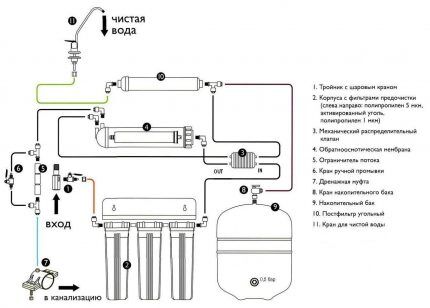
The basic package includes the necessary elements that can ensure effective reverse osmosis work.
If water contamination exceeds the norm or the water supply system is not able to ensure normal operation of the device, then it will be improved with the help of additional equipment.
Interesting facts, pros and cons of membrane cleaning are presented in this article.
Components of a standard kit
Typically, reverse osmosis systems are supplied as a kit, which already contains everything needed, even fasteners.
The list of equipment may vary depending on the model and include the following items:
- reverse osmosis membrane;
- a block with pre-cleaning flasks, in which three filters are installed: two mechanical and one carbon;
- postfilter;
- mineralizer;
- tap for drinking water;
- filter replacement wrench;
- key for the membrane body;
- set of tees-connectors;
- faucet mounting panel;
- set of flexible hoses, etc.
Before purchasing, you need to decide on issues such as membrane performance and the availability of additional modules.
For example, you can simultaneously install a post-filter, a mineralizer, and a bioceramic cartridge, or limit yourself to just a post-filter.
When choosing a reverse osmosis system, you should pay attention to the size of its elements. More often popular models have standard sizes. This allows you to select suitable options from different companies when replacing membranes or filters.
But if the dimensions of the model are unique, you may have to install only special branded cartridges, and this is not always profitable or convenient.
Installation of a reverse osmosis system
The variety of reverse osmosis systems is very large. Therefore, further installation of the filter will be considered using the example of the most common one - with five-stage cleaning and a storage tank.
Step #1 - study the functioning of the filter
Before installation, it doesn’t hurt to understand exactly how the liquid moves through the system. First you need to make an insert into the water pipe to connect to it a hose connecting the water supply to the pre-treatment filters. Water passes through these filters, leaving particles of mechanical and chemical contaminants in their cartridges.
The prepared flow then moves to the membrane and passes through its body. Two hoses extend from the membrane block. One of them is intended for concentrate and is connected to the sewer system.
With the help of this hose, contaminants are disposed of. Through the second hose there is permeate, i.e. purified water flows to the expansion tank. Here water is accumulated and stored.It is almost impossible to do without such a container and ensure the normal functioning of the reverse osmosis system.
The fact is that the average productivity of a household membrane is usually about seven liters per hour. At some point, such a slow flow may not be enough for domestic needs.
The storage tank completely solves the problem. It stores a sufficient amount of clean water, which is constantly replenished as the liquid decreases. After the expansion tank, water can be supplied directly to the drinking water tap, but this is rarely done.
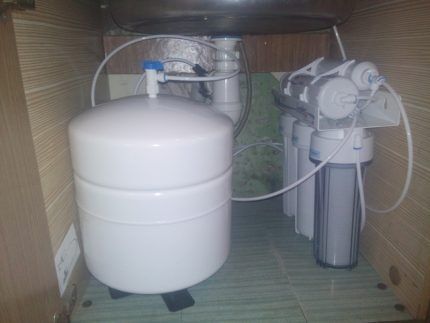
If you have already decided to provide your home with high-quality water, it makes sense to pay extra for a high-quality post-filter, mineralizer or other similar device. Some people prefer to use several of these blocks at once.
In this case you need select faucet with two valves. It is connected in such a way that only purified water flows through one valve, and enriched with minerals through the other.
This is done in order not to use mineralized or structured water for cooking, since this effect will simply disappear when boiled. Thus, the use of a tap with two valves allows you to increase the service life of the mineralizer.
Step #2 - choose the optimal installation location
You should immediately choose the location for installing the reverse osmosis system itself and the drinking water tap. Most often, this element is placed on a kitchen sink, for which a small hole is drilled in its body.
If desired, the location of the drinking water tap can be changed.But then it is imperative to provide access to the sewer system so that water that accidentally overflows over the edge of the container does not spill throughout the kitchen.
In a spacious kitchen, you can install another small sink specifically for drinking water, but such a need arises extremely rarely. It is most convenient to install the system elements close to the drinking tap and from each other. The shorter the hoses through which the water moves, the more efficient the system works.
Traditionally, the system is installed in the same place as household filters - under the sink. The dimensions of the storage tank and filter block allow this to be done. Before starting work, check the system for compliance with the incoming parameters.
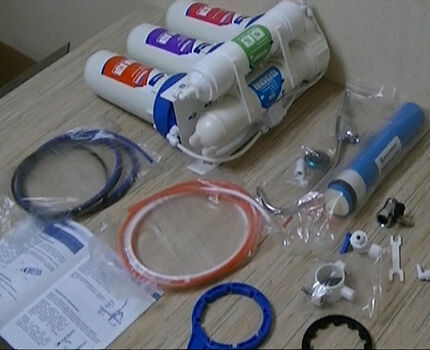
You need to check:
- pressure in the membrane tank;
- incoming water temperature;
- pressure at the inlet to the reverse osmosis system.
Indicators may be different; each manufacturer indicates them in the operating instructions separately for each model. Install the system away from heating devices, in a place protected from sunlight.
First, turn off the flow of cold water, and if the mixer has only one handle, then turn off the hot one as well. Then open the tap to relieve the pressure, and then close it.
Before installing the connecting tubes, membrane, and reverse osmosis cartridges, you must disinfect your hands.
Step #3 - install a drinking faucet
If the sink already has an additional hole, for example, for a liquid detergent dispenser, it can be used as a drinking faucet for a reverse osmosis system. If there is no such hole, you will have to make it yourself.
Particular care should be taken when working on an enamel surface so as not to damage the protective layer.
Installation is carried out on the edge of the sink or on the countertop area near the sink. A flat horizontal surface with a diameter of about 4 cm is suitable for installation. Before installation, you need to make sure that the space under the sink allows you to fix the faucet and connect the pipes without kinks.
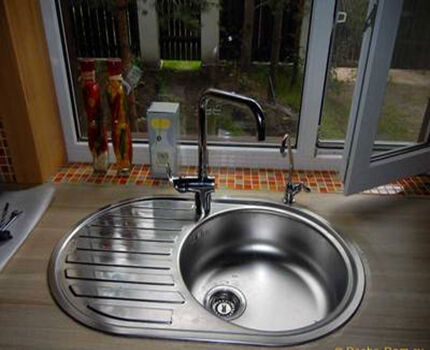
Some sinks have holes for installing an additional faucet.
If it is not there, then perform the following actions:
- Hole preparation. Using a drill with a diameter of 6 mm, drill a hole in the sink or countertop at low speed. To avoid damaging the surface and preventing chipping, you can stick a patch on it. For ceramic or stone surfaces, use a carbide drill.
- Expansion of the hole. Next, take a drill with a diameter of 11-12.5 mm, enlarge the hole and remove the patch. If the edges are torn, they are cleaned with a needle file or file.
- Surface cleaning. Remove shavings, especially carefully remove metal shavings before they leave rusty stains on the surface of the sink.
- Sealing. Before installing the faucet into the hole, put a decorative cover and a rubber washer on its lower part to seal the connections.
- Assembly. The lower base of the faucet is inserted into the hole, a rubber, plastic, and then a metal washer is placed on it from below. The resulting structure is tightened with a nut using a 14 mm wrench or tubular wrench.
A fitting is screwed onto the lower base, inside of which there should be a rubber gasket.
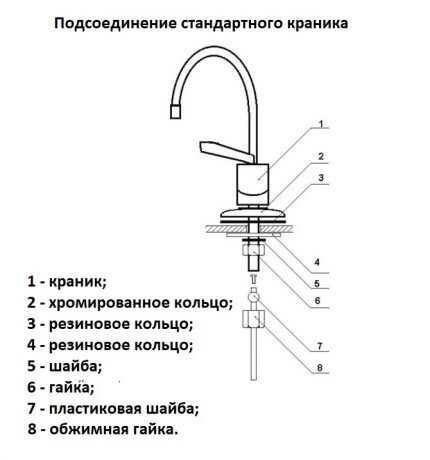
Step #4 - connect to the water supply
First, of course, you need to turn off the cold water supply. Connection to the water supply occurs using an adapter adapter. The most convenient place to install it is the connection between the water pipe and the flexible connection of the kitchen faucet.
Place a basin under this area to drain the remaining water and install:
- Disconnect the flexible connection of the mixer from the water pipe, check for the presence of a rubber seal in the adapter and screw the connection onto it on both sides, tightening it with a wrench.
- Unscrew the ball valve nut from the adapter to fit it onto the plastic tube.
- The tube is pulled onto the ball valve. Tighten the nut by hand without applying much force.
To improve the tightness, Teflon tape is wound on the external thread of the adapter and water pipe.
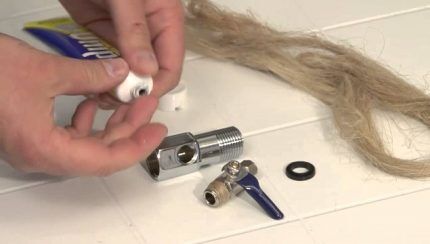
Step #5 - crash into the sewer system
To drain the contaminated water that remains after passing through the reverse osmosis membrane, connect to the sewer using a drainage clamp.
The insertion point must be at a level above the water seal, i.e. siphon. On a vertical or horizontal section of the drain pipe, above the siphon, make a hole with a drill with a diameter of 7-8 mm.
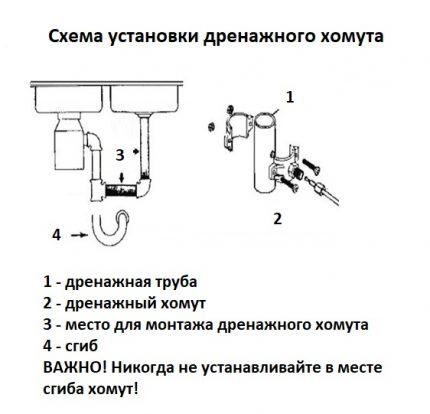
Before installing the clamp, a rubber gasket is glued to its bracket with the hole. Then fasten the clamp, tighten the screws evenly and ensure that the brackets on opposite sides sit parallel and are pressed tightly, and the holes in the drain pipe and the clamp coincide.
A black tube is inserted into the fitting of the drainage clamp, lubricated with silicone grease and with a pre-fitted nut, which is tightened tightly, but not tightly.
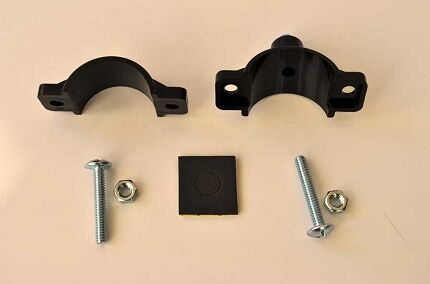
Step #6 - install the valve on the drive
The storage tank is used to create water reserves and maintain stable pressure. Since reverse osmosis purification occurs slowly, a reserve tank helps to quickly obtain the required amount of water that has been purified in advance.
Typically the drive is installed vertically on a special stand. But if such a need arises, it can be placed horizontally or mounted on brackets.
If there is not enough space under the sink, the storage tank is placed somewhere nearby, for example, in a nearby kitchen cabinet.For the hoses you will have to make small holes in the walls of the kitchen furniture.
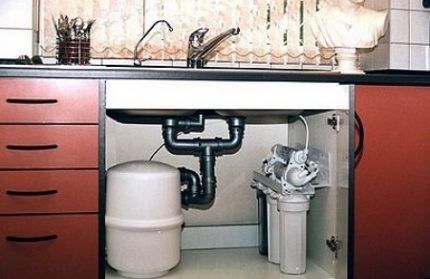
The tank itself must be prepared before installation - a plastic tap must be attached to the threaded connection. FUM tape is screwed onto the threads of the storage tank in two or three layers.
Then, without using tools, screw the tap onto it until it stops. A plastic tube is inserted into the tap fitting. Its other end is connected to a carbon post-filter (the last stage of purification).
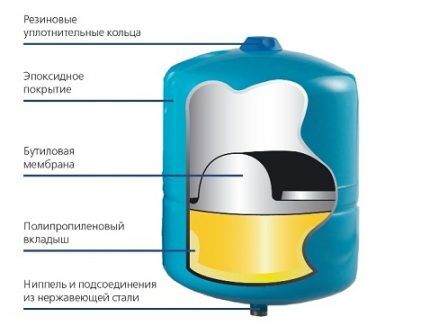
Another important point is the pressure in the tank. The pressure is measured with a pressure gauge and, if necessary, air is pumped into the tank.
Step #7 - install the filtration unit
When choosing a place under the sink for the filtration unit, take into account that the tubes that come with the kit are usually 1.5 m long, and they should be located freely, without tension or kinks.
If necessary, filters can be hung on the inner wall of the cabinet. It is also necessary to ensure free access to the ball valve. The pre-filter flasks are mounted on a special strip, which can be hung on the wall of the kitchen cabinet under the sink.
The location should be easily accessible so that it is convenient to replace used cartridges. To open the flasks, you must use a special key.
First of all, install the prefilter cartridges according to the instructions. Their location must not be confused, otherwise the device may malfunction.
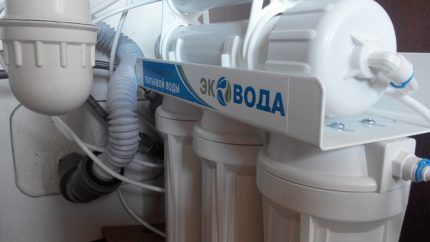
To install the cartridge, remove the protective film and place it in the housing, which is installed back in place. Make sure that the rubber seal is not distorted. After the filters are installed, a housing containing a reverse osmosis membrane is installed on top of special holders.
A post-filter and a mineralizer or other modules are fixed above the membrane. After this, all elements of the system are connected with hoses, which are secured with special clamps.
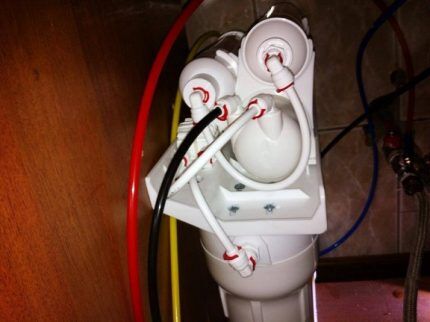
The connection procedure is usually fully described in the instructions. You need to connect the water supply to the prefilters. Discharge water from the filters to the membrane, and then run two hoses from the membrane: to the sewer and to the storage tank. A hose is led from the storage tap to the post-filter, and then to the drinking water tap. Another hose is passed through the mineralizer.
The membrane is installed in the housing as follows:
- disconnect the tube from the body fitting;
- use a key to unscrew the lid;
- insert the membrane into the housing and press it until it stops;
- close the lid and insert the tube into place.
The tubes for connecting the filtration elements are lubricated with silicone grease or petroleum jelly and connected in this order:
- The water supply tube is connected to the inlet of the first filter.
- The storage tank is connected to the entrance to the filter, which performs the fifth stage of cleaning.
- The fifth stage outlet is connected to a purified water tap.
- The second end of the tube, which is connected to the sewer pipe, is connected to the outlet of the flow limiter.
After checking that all tubes are connected correctly, the equipment can be considered ready for use. All that remains is to fill it with water and wash it.

Step #8 - fill and rinse the filter
Before filling the filter for the first time, close the valve on the tank and the shut-off valves of the pipeline.
Then proceed as follows:
- Open the drinking water tap;
- Unscrew the general valve of the water treatment system;
- Open the ball valve that supplies water to the reverse osmosis filter.
You should not expect water for the first 5-10 minutes - air will escape from the system. When the water begins to flow out, its pressure will be small, because at this moment the tank tap is turned off. There is no need to open it yet; you need to wait for water to rinse the filter device for two hours.
After draining a certain amount of water, turn off the tap and leave the device alone for another 10 minutes, during which time the installation is checked for leaks. If a leak is detected, tighten the leaking connections.After making sure that the system is working properly, open the tank valve.
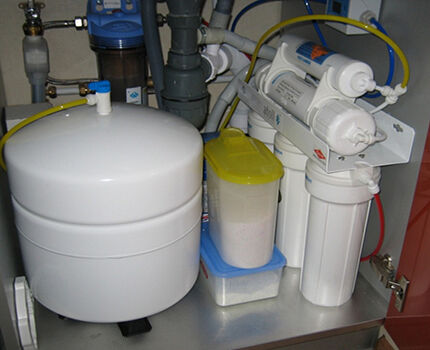
Filling the tank can take several hours, the speed depends on the water pressure. Then the system is flushed again - drinking water after first filling the tank is strictly not recommended.
Only after the second filling of the container can you begin to use purified water.
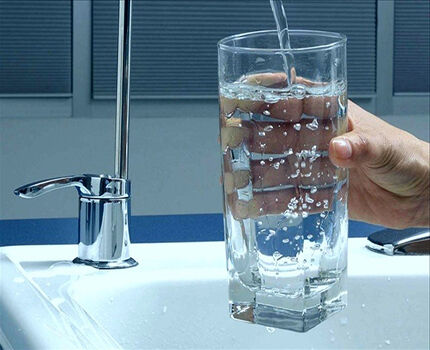
The primary water accumulated in the tank should be completely drained into the sewer. After this, the water is opened again for purification. When the tank is full, you can start using the system as usual.
Tips for use
If, after starting the system, the drinking water has a milky tint and contains small air bubbles, do not worry. This is the influence of air dissolved in water, it is not dangerous. This effect will disappear after a few days or weeks.
If the pre-filters become dirty too quickly, as well as the presence of mucus on the cartridges, this may be a symptom of low pressure in the water supply network. The problem is usually solved with a pump.
Sometimes washing the carbon filter can cause the third filter to become dirty immediately after installation. To prevent this from happening, it is better to install the third filter after the carbon cartridge has been washed. But you should not try to rinse the carbon filter under running water, as this can ruin it.
Do not neglect washing the carbon cartridge, as this can lead to rapid clogging of the membrane. The same effect can be produced by too high pressure in the water supply system, too infrequent replacement of pre-filters or the use of low-quality cartridges, or clogging of the sewer system.
If scale forms in the kettle when boiling water, you should check the connection order. There may be a hose connected to the drinking tap through which the concentrates are supplied, and the purified water goes down the drain.
If the purified water has acquired an unusual smell and taste, it is necessary to check the pre-filters as soon as possible. Perhaps their resource has been exhausted and needs replacement. This phenomenon may also indicate the presence of bacterial contamination.
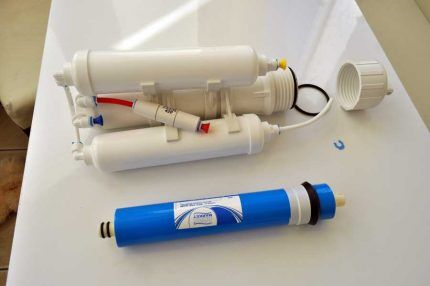
Pre-clean cartridges should be replaced every six months or more frequently. A new membrane usually needs to be installed every three to five years. The condition of the purified water should be checked annually. If the salt content exceeds 20 mg/l, the membrane must be replaced.
Replacing filtration elements
To replace the cartridge fillers with your own hands, close the water supply shut-off valves and the device. Then open the purified water tap and drain the remaining liquid.
Next, disconnect the plastic tubes and remove the equipment from the cabinet. You can remember the location of the tubes by marking them or using a camera (if the tubes are colored).
Unscrew the housing caps and remove the exhausted cartridges and filtration membrane. Plastic flasks and lids are washed with dishwashing detergent.
When installing new filter elements, carefully follow the installation procedure and check for the presence of a rubber gasket on the cover.
Rubber sealing rings are wiped dry before installation. The system is assembled and washed in the same way as when installing a new device.
Replacement filter elements are carried out with the following frequency:
- reverse osmosis membrane - every 24-30 months;
- carbon post filter - once every 12 months;
- prefilters - once every 6 months.
The frequency of replacement largely depends on the quality of the water. New replacement elements are replaced with the same ones, checking their markings.

Installation of additional accessories
The operation of even such serious equipment as a reverse osmosis filter can be made more efficient by installing additional elements.
Such as for example:
- Pressure regulator. The equipment is designed to protect water supply elements from pressure drops, exceeding permissible values at the entrance to the filtration system and compensation water hammer.
- Leak protection system. It is installed in front of the filter and shuts off the water in case of leaks or water getting on it. Minimizes risks and limits the amount of damage caused, but does not completely eliminate the possibility of leaks.
- Nitrate prefilter. Used for effective removal of nitrates, the installation location is agreed upon with specialists.
- Ice maker. It is connected through a tee into the gap in the connecting tube leading to the drinking tap.
Before installing the filter, measure the pressure in the line with a pressure gauge. For values greater than 6.6 atm, a gearbox is installed; for values less than 2.2 atm, a pump is installed, which will create greater pressure.
For devices that are most often used to improve the functionality of reverse osmosis, a more detailed description is provided below.
Item #1 - Pressure Booster Pump
The membrane filter, which is the basis of the reverse osmosis system, can only fully function at a certain water pressure in private house or apartment.
If the maximum pressure does not exceed 2.8 atm, then for normal operation of the filter it is necessary to additionally install a pump.
If you have to purchase additional equipment, it is better to do it from one manufacturer and be guided by the connection diagrams developed by him.
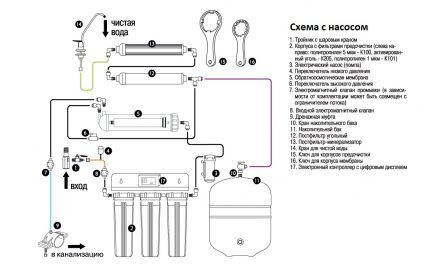
The pump is installed only in conjunction with pressure regulation sensor, which is responsible for turning it on when the pressure drops and turning it off when it jumps to the maximum.
The sensor is mounted in front of the storage tank, in the rupture of the tube. If the quality of tap water is poor, a main coarse filter is installed in front of the pump.
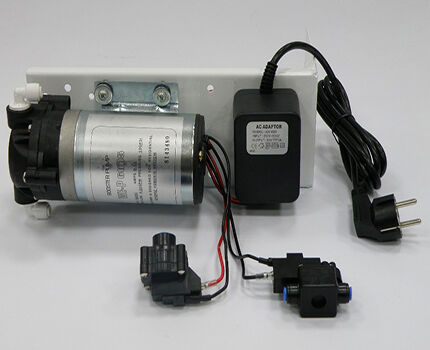
If there is a danger of increasing water pressure in the system to 3-4 atm, then to prevent leaks, you need to install a special pressure reduction valve in front of the pump.
Element #2 - ultraviolet lamp
Sometimes favorable conditions arise in a reverse osmosis filter for the rapid development of microorganisms due to an increase in water temperature or the system being idle for a long time.
This leads to the fouling of prefilters with microorganisms, a decrease in pressure and a deterioration in equipment performance. And then ultraviolet filters are used to disinfect water.
The device consists of the following parts: a stainless case with a UV lamp located inside and a power supply that converts the mains voltage into the values necessary for the lamp to operate and protects it from power surges.
Water passing inside the housing is illuminated by ultraviolet rays and disinfected.
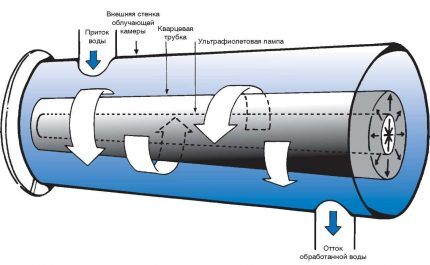
The installation location of the ultraviolet lamp may depend on the goals that need to be achieved:
- at the filter inlet — to eliminate strong biological contaminants in tap water;
- between tap and container - to protect against microorganisms entering the tank from the drinking tap.
For ease of installation, the lamp has two clips that help secure it to the filtration unit or any other surface.
Element #3 - water mineralizer
The water that passes through the membrane filter is 90-99% purified and gets rid of any impurities, including mineral elements that are useful and necessary for the body.This water tastes sour.
Mineralizers replenish the lack of essential minerals and adjust the PH level. Mineralizer cartridges of different brands may differ in their composition and resource and enrich the water with calcium, zinc, magnesium, and other elements.

In some models of reverse osmosis filters, the mineralizer also plays the role of a filter and is installed as the last stage of purification.
Conclusions and useful video on the topic
A clear video on how to install reverse osmosis yourself can be viewed here:

This video contains useful information on replacing pre-filters:

To install a reverse osmosis filter with your own hands, you need to not only prepare the tool, but also conduct a water analysis, study the parameters of the plumbing system and filtration device.
You need to carefully study the instructions and strictly follow the manufacturer’s recommendations. Properly selected equipment is 50% of success. And then the installation itself will not be difficult. And timely maintenance of the system and replacement of used elements will provide the house with high-quality drinking water.
Share with readers your experience in improving the quality of drinking water. Please leave comments on the article and ask questions about the topic that interest you. The feedback form is located below.
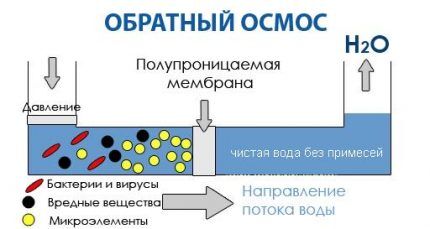




In principle, it is not always necessary to change the osmotic filter membrane itself. It can be washed with a solution of citric acid.It is clear that this method is not recommended by manufacturers and does not completely restore filtering properties. However, this will allow you to hold out for some time while you find the right element, which is generally better to always keep in stock.
I now remember how much I struggled with installing these filters. The main disadvantage of this system is the size, or rather the storage capacity. I didn’t calculate the dimensions, and as a result, this container didn’t fit. I understand that it’s impossible without her, but that doesn’t make it any easier)). I had to place it in a nearby cabinet, for which I cut holes for the hoses. In general, it turned out well. So, don’t be lazy, measure the space under the sink.
Tell me how to add or reduce pressure in the accumulator? (I think I released the gas and now there is little pressure in my accumulator). Thank you.
In general, it is better to monitor the pressure in the tank; you can do this with the help of scales, since the pressure should not be just a number, for example, 3 atm, but a number corresponding to your pressure in the water supply.
You just need to understand the principle of operation of the storage tank.
It consists of two volumes - the first is air, which is pumped up by any automobile compressor or pump, the nipple there is like a car tire. This air is, say, 3 atm. Container number 2 compresses - this is a rubber bulb (membrane), if your pressure in the water supply is less than 3 atm, then water will not get into this container until you reduce the air pressure in the tank.
I would recommend the following algorithm.
We pump 4 atm into the tank, put it on the scales, and connect it to the system. We wait and see if water comes in (the weight of the tank increases).If a tank of 10 liters is the full volume, then 4-5 liters incoming is normal. With decreasing air pressure (gradual leakage), this volume will increase. In a year it will be approximately 6-8 liters, which will already stretch the rubber membrane, causing it to simply tear (water comes out of the air injection nipple if you check the pressure by pressing the spool).
I.e. if we tried to raise the tank and realized that it was full, then we either need to pump it up or buy a new one...
Well, scales are not entirely necessary, close the tap at the inlet of the filter, and pour the purified water into a container, estimate its volume - it should be about half the volume of the tank.
If you don't have enough volume for your family, buy a larger tank or add additional tanks through tees!
in the storage tank, the air pressure should be in the range of 0.4 - 0.6 atm. By no means higher. The pressure on an empty tank is measured with a tire pressure gauge. If necessary, air is pumped up with a bicycle pump
Tap water is generally Drinkable. It cleans better than any household filter. It's easier to die from water from the store.
It’s suitable, it’s suitable, at the outlet at the Vodokanal, but on the way to the house through old pipes it collects so much unnecessary and harmful that it needs to be filtered.
Good evening everyone! We installed a reverse osmosis system with 5 degrees of purification UNIKORN, but the water after cleaning has oily stains. What is not installed correctly?